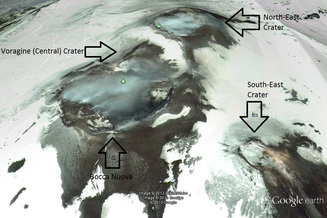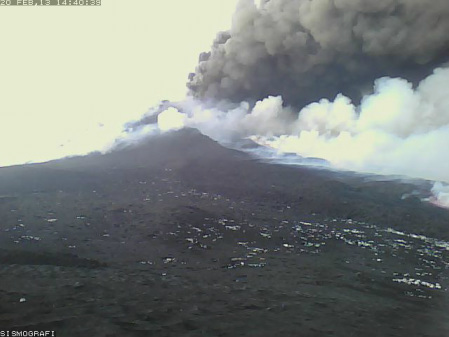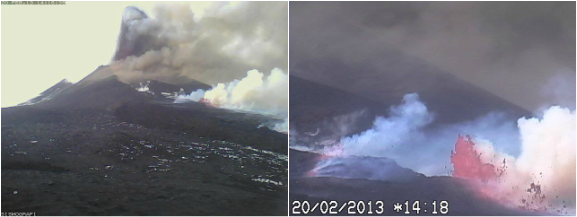 Google Earth annotated image showing crater locations. Mt Etna, has had a relatively active start to the year. The major focus of this recent activity has been at the South-East (SEC) and Bocca Nuova (BN) craters, indicated in the Google Earth image to the right. This activity has included a mixture of activity types including: strombolian , jetting (Hawaiian type) and ash emissions. This type of activity has been prominent at the volcano over the past few months, particularly in the BN crater (as I was lucky to witness in July). However, the SEC has been relatively quiet for 9 months previous to this recent reactivation. I thought that this would be a good point to briefly discuss the summit of Mt Etna. Despite a very prominent summit area from a distance, Etna has three main areas: the Central Craters (Voragine and BN), the North East crater (NEC) and SEC (and NSEC). The NEC and Voragine mostly emit gas passively. All of these contribute in a different way to the volcanism at Etna and all need to be studied in detail to gain an insight into the complexities of an active volcano. The first image below shows minor ash emission during the activity from the NSEC on the 20th February 2013. At this time of the year, the slopes of Etna are used for skiing. In certain places you can see white snow poking through a fresh covering of black ash (as a result of the basaltic magma). The ash emissions from the NSEC are clearly separated from a lower area of steam. It is even possible to notice some incandescence near to the NSEC (just below the NSEC) and against the right edge of the image and half way down. Other images below this show much more vigorous activity with the first image on the left showing a clear lava fountain. The image to the right of this shows more clearly the incandescence I mentioned earlier and shows the likely cause of all the steam (the result of lava heating snow)! This could be indicative of a fissure or a lava flow with fast flowing lava allowing it spill up over the edges spectacularly. Although the images are not 100% revealing so I can't be certain. For a discussion of the causes of strombolian and hawaiian activity please see a couple of my previous posts. Etna continues as one of the most active volcanoes on the Earth and will continue to provide a spectacular show for all of us over the coming months and far off into the future. Comments are closed.
|
Archives
July 2023
|



 RSS Feed
RSS Feed